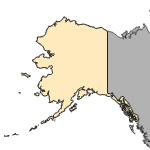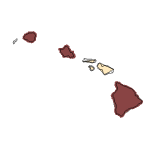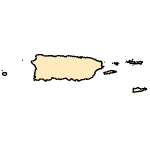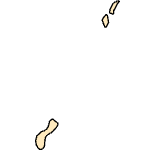Pomacea diffusa
(spike-topped applesnail)
Mollusks-Gastropods
Exotic |
|
Common name: spike-topped applesnail
Synonyms and Other Names: Pomacea bridgesii diffusa Blume 1957
Identification: A large globose conic shape, 6 whorls, shell color varies from yellowish to dark olive-brown color, radial stripes, more pronounced spire than other Pomacea species (Blume 1957; Pain 1960). Egg color of applesnails are often used to help identify the species. For P. diffusa, they are a tan to salmon color (Rawlings et al 2007).
Size: Up to 60 mm height (Thompson 1984); generally 42 mm height, 33 mm width (Blume 1957); average 38 mm height (Pain 1960).
Native Range: Tropical and subtropical South America. The type locality is a lagoon in the city Santa Cruz, Bolivia; it is also native to Peru and the Amazon system of Brazil (Blume 1957).



|

Alaska |

Hawaii |

Puerto Rico &
Virgin Islands |

Guam Saipan |
Hydrologic Unit Codes (HUCs) Explained
Interactive maps: Point Distribution Maps
Nonindigenous Occurrences:
Table 1. States with nonindigenous occurrences, the earliest and latest observations in each state, and the tally and names of HUCs with observations†. Names and dates are hyperlinked to their relevant specimen records. The list of references for all nonindigenous occurrences of Pomacea diffusa are found here.
Table last updated 12/18/2025
† Populations may not be currently present.
Ecology: Freshwater rivers, streams, ponds, and wetlands. In general, applesnails feed primarily on plants. In addition, it has been shown that P. diffusa readily feed on carcasses of dead aquatic animals (Aditya and Raut 2001). All snails in the genus Pomacea possess both lungs and gills and the sexes are separate (Mackie and Claudi 2010). The female lays a clutch of 200-600 eggs (each egg 3 mm in diameter) above the water surface on emergent plants or other hard substrate such as rock or concrete (Mackie and Claudi 2010). The eggs hatch and the young snails fall into the water. The life span is several years.
Means of Introduction: Howells et al. (2006) summarized possible justifications for the existence of wild applesnail populations which include human food, aquarium and watergarden pets, research animals, weed control, and as hitchhikers on ornamental nursery plants. Applesnails have been in the pet trade for decades (Howells 2002). Pomacea diffusa has been found for sale in the aquarium pet trade in Florida (Morrison and Hay 2011) as well as in Singapore, a major source of exports around the world (Ng et al. 2016).
Status: Pomacea diffusa is established in Florida (Thompson 1984) and Hawaii (Cowie et al. 2017). It may also be established in Mobile, Alabama (Howells et al. 2006). In Puerto Rico, an applesnail identified as Pomacea bridgesii was collected as early as 1965. However, with the change of identification of introduced specimens collected globally (Cowie et al. 2017), it is most likely P. diffusa on the island.
Impact of Introduction: The impacts of some species of applesnails, such as P. canaliculata, as an agricultural pest are well known (Joshi et al 2017). However, in a study by Howells (2002) he found P. diffusa (known as P. bridgesii at the time of his study) rejected rice sprouts and preferred periphyton-covered rocks. He concluded that wild populations of P. diffusa may not be a significant threat to macrophytes and crops in the United States. In a laboratory study by Morrison and Hay (2011), they found P. diffusa avoided most plants offered to them preferring animal tissue instead. Therefore, although the impact on plants may be minimal. However, P. diffusa could have other impacts by competing with other organisms for their preferred foods.
References: (click for full references)
Aditya, G., and S.K. Raut. 2001. Food of the snail,
Pomacea bridgesi, introduced in India. Current Science 80(8):919-921.
Blume, V.W. 1957. Eine bis heute unbekannte Unterart von Pomacea bridgesii Rve. Opuscula Zoologica (1957-1960), Nr. 1, 2 pp.
Cowie, R.H., K.A. Hayes, E.E. Strong, and S.C. Thiengo. 2017. Non-native apple snails: systematics, distribution, invasion history and reasons for introduction. Pages 3-32 in Joshi R.C., Cowie R.H., & Sebastian L.S, eds. Biology and management of invasive apple snails. Philippine Rice Research Institute (PhilRice), Maligaya. Science City of Muñoz, Nueva Ecija 3119, 406 pp.
Hayes, K.A., R.H. Cowie, and S.C. Thiengo. 2009. A global phylogeny of apple snails: Gondwanan origin, generic relationships, and the influence of outgroup choice (Caenogastropoda: Ampullariidae). Biological Journal of the Linnean Society 98:61-76.
Hayes, K.A., R.C. Joshi, S.C. Thiengo, and R.H. Cowie. 2008. Out of South America: multiple origins of non-native apple snails in Asia. Diversity and Distributions 14(4):701-712. DOI:10.1111/j.1472-4642.2008.00483.x.
Howells, R.G. 2002. Comparative feeding of two species of applesnails (Pomacea). Ellipsaria 4(1):14-16.
Howells, R.G., L.F. Burlakova, A.Y. Karatayev, R.K. Marfurt, and R.L. Burks. 2006. Native and introduced Ampullariidae in North America. Pages 73-112 in Joshi, R.C. and L.S. Sebastian, eds. Global advances in the ecology and management of golden applesnails. Philippine Rice Research Institute. Munoz, Ecija 3119, 406 pp.
Joshi R.C., Cowie R.H., and Sebastian L.S. (eds). 2017. Biology and management of invasive apple snails. Philippine Rice Research Institute (PhilRice), Maligaya, Science City of Muñoz, Nueva Ecija 3119, 406 pp.
Mackie, G.L., and R. Claudi. 2010. Monitoring and Control of Macrofouling Mollusks in Fresh Water Systems. CRC Press Taylor and Francis Group, Boca Raton, Florida, 508 pp.
Morrison, W.E., and M.E. Hay. 2011. Feeding and growth of native, invasive and non-invasive alien apple snails (Ampullariidae) in the United States: invasives eat more and grow more. Biological Invasions 13:945-955.
Ng, T.H., S.K. Tan, W.H. Wong, R. Meier, S-Y. Chan, H.H. Tan, and D.C.J. Yeo. 2016. Molluscs for sale: assessment of freshwater gastropods and bivalves in the ornamental pet trade. PLoS ONE 11(8):e0161130. DOI:10.1371/journal.pone.0161130.
Pain, T. 1960. Pomacea (Ampullariidae) of the Amazon River system. Journal of Conchology, 24(12):421 - 432. [16 December]
Rawlings, T.A., K.A. Hayes, R.H. Cowie, and T.M. Collins. 2007. The identity, distribution, and impacts on non-native apple snails in the continental United States. BMC Evolutionary Biology 7:97. DOI:10.1186/1471-2148-7-97.
Thompson, F.G. 1984. An identification manual for the freshwater snails of Florida. University of Florida, Gainesville, Florida. Accessed August 22, 2018.
Author:
Benson, A.J.
Revision Date: 8/9/2019
Peer Review Date: 8/9/2019
Citation Information:
Benson, A.J., 2025, Pomacea diffusa Blume, 1957: U.S. Geological Survey, Nonindigenous Aquatic Species Database, Gainesville, FL, https://nas.er.usgs.gov/queries/factsheet.aspx?SpeciesID=2662, Revision Date: 8/9/2019, Peer Review Date: 8/9/2019, Access Date: 12/18/2025
This information is preliminary or provisional and is subject to revision. It is being provided to meet the need for timely best science. The information has not received final approval by the U.S. Geological Survey (USGS) and is provided on the condition that neither the USGS nor the U.S. Government shall be held liable for any damages resulting from the authorized or unauthorized use of the information.